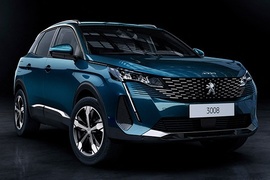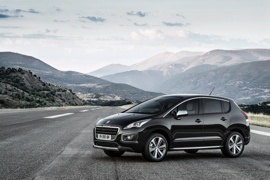
PEUGEOT 3008
Generations Timeline, Specs and Pictures

The facelift for one of the most successful SUVs built by Peugeot was revealed in late 2020: the 3008 received an important refresh, even if the 2016 model didn’t look bad at all.
The 2016 Peugeot 3008 won the “Car of The Year” award in Europe. It was that kind of a mix between comfort, room, exterior dimensions, and fuel-efficiency that brought it to the light. On top of that, a futuristic (for that era) instrument cluster and a low driving position made it a great choice, even if the underpinnings were based on the Peugeot 308 model.
In 2020, the cross-over was refreshed with a new design for the front grille, and a more powerful look for its headlights. A specific element was the light strip that went down from the LED headlights to the apron. It mimicked a fang of a lion, the French’ brand logo. The bumper was reshaped and it gained two side-scoops, in front of the wheels. The sculptured front fenders were modified as well. In the back, the taillights were changed to a full LED lamps system, including the reversing lights.
Inside, the 3008 stunned the world with its i-Cockpit instrument cluster back in 2016, when it was launched. It was enhanced with a new graphic and new options for the 2020 model year. The infotainment unit featured a 10” high-definition display, placed on top of the center stack. Due to the COVID-19 pandemic, in some countries, the 3008 was available for completely online purchase and delivery.
The 3008 was available with a choice of gasoline, diesel, and hybrid systems. The hybrid version was the only one that offered an all-wheel-drive system.

The French auto maker had a great success on the crossover market with the 3008, however, when it came to renewal, they decided to build a new SUV from scratch.
The 3008 shared its platform with the Peugeot 308, however, the dimensions were increased considerably.
The exterior was designed to give the model an attractive look, and moreover, the exterior reflected the functional changes that were made for the new SUV to perform well: an increased ground clearance, wider tracks and a coupe profile.
Despite the elegance displayed by the new 3008, the new model joined the classic SUVs market.
The 3008 was a strong rival for its competitors, coming with the latest technologies available on the market. The cockpit consisted of a small steering wheel and fully digital instrumentation, as well as a standard multimedia touchscreen.
Peugeot grew the 3008’s reputation with the quality of the materials used, as well as the modern aeronautics-like design.
The increased wheelbase created a big advantage for the rear seats passenger by improving the legroom available.
The load area was a good size, offering 520 liters and up to 1482 liters with the rear seats folded.
The 3008 was loaded with lots of safety features such as Active Safety Brake and Distance Alert, active lane departure warning, driver attention warning, automatic adaptive headlamp main-beam, speed limit sign recognition, adaptive cruise control with stop function available for the automatic transmissions and an active blind-spot monitoring.

The 2013 Peugeot 3008 was the facelift of a 3-in-1 car that was built to fill the needs of families transportation, either if it was a daily commute or a long trip around Europe.
Before the world financial crisis in 2008-2010, nobody knew where the market will go. If it will go to the hatchbacks, SUVs, or minivans. So, Peugeot built a car that was all three of them: the 2009 Peugeot 3008.
In 2013, the world was on the recovery from financial problems and the French manufacturer decided to do a facelift for its 3008 model. By that time, it was clear that the market will go for SUVs but the Peugeot wasn’t ready for that. Instead of building a completely new vehicle, the marketing department decided to change the look of its already built 3008. The car was built on the EMP2 platform, which was used for many vehicles including the hatchback 308. The new styling showed new headlights, new bumpers, and new LED taillights.
The interior was enhanced. Bluetooth connectivity was added as standard across the range and, as an option, a head-up display in front of the driver. For the top trim version, a rear back-up camera was installed. Due to a higher seating position for all the passengers, the leg and headroom were generous for all seats.
Since the market direction was toward the SUV and crossover segment, Peugeot installed an intelligent front differential that helped to find the grip when the car was in off-road mode. The 3008 was only front-wheel drive so the biggest off-road challenge it could tackle was some unpaved roads.

Shown for the first time at the 2008 Paris Auto Show, the Peugeot 3008 was officially launched in May 2009 after undergoing minor design changes.
The Peugeot 3008 stood out as a car of comfortable driving with a very efficient engine range.
The French vehicle producer developed this car as a crossover between the 308 and the 4007 aiming for the urban SUV - practical MPV market segment. The 3008 promised reduced fuel consumption and emissions level with a good soundproofing for a pleasurable drive even for the diesel models.
Its main attractions were the new 6-speed sequential gearbox developed by PSA along with a new 2.0 HDI FAP diesel engine which to comply with EURO 5 emissions standard. The interior has been changed in style, following a more organized pattern and aiming for the renown “German quality”.
The 3008 was not offered with a 4-wheel-drive, however, Peugeot equipped the vehicle with a system named “Grip Control” which did the trick on surfaces like snow or mud.
The car benefited from a huge load area due to its foldable rear seats. The load volume increased from 512 liters to 1,604 with the seats folded. The fuel consumption was reduced, with only 4.9 liters/100 km, the 1.6-liter engine being the most efficient.























































